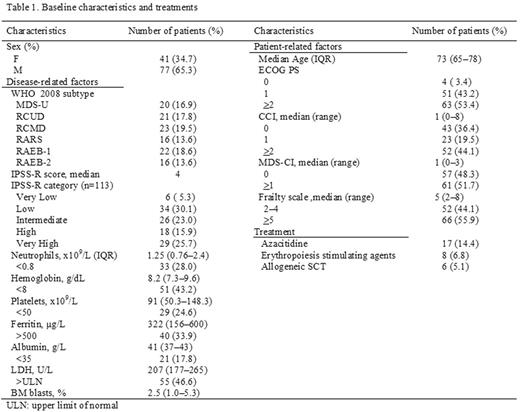Abstract

Introduction
Prognosis of myelodysplastic syndrome (MDS) is influenced by several factors including disease-related factors, treatment options, and patient-related factors. The revised International Prognostic Scoring System (IPSS-R) is widely adopted, which is based on disease-related factors. Frailty and comorbidity are clinically important patient-related factors. Recent studies showed that the Charlson comorbidity index (CCI) or MDS-comorbidity index (MDS-CI) has a marked impact on overall survival (OS). Patients with MDS are often of advanced age and frail. There are limited studies that have examined the clinical significance of frailty in patients with MDS. Furthermore, little is known regarding the association between frailty and comorbidity or the mechanisms by which they affect survival. We investigated the prognostic effect of frailty and its association with comorbidity.
Patients and Methods
This retrospective analysis included 118 consecutive patients diagnosed with MDS between June 2007 and May 2016 at Saiseikai Nakatsu Hospital, Japan. Diagnosis was made based on the WHO classification. The following information was collected using our institution's database: WHO classification, age, ECOG Performance Status (PS), IPSS-R score and risk classification, cause of death, albumin, lactate dehydrogenase, and ferritin. Frailty was evaluated using the Rockwood clinical frailty scale (Rockwood et al, 2005). Comorbidity was classified using CCI (Charlson et al, 1987) and MDS-CI (M.G. Della Porta et al, 2011). The primary endpoint was OS. Univariate and multivariate analyses were performed using a Cox proportional hazards regression model and hazard ratio (HR) was calculated to identify significant covariates associated with OS. OS was estimated using Kaplan-Meier method and compared using log-rank test. Cumulative incidences for infection-related mortality were calculated using the cumulative incidence function to account for competing risks. Gray's test was used to evaluate overall differences among cumulative incidence functions.
Results
Patient baseline characteristics are summarized in Table 1. A total of 118 patients (77 males, 41 females) were included. The median age was 73 years (IQR, 65-78). The median IPSS-R score was 4.0 (2.5-6.5) and 41.6% of patients scored high or very high in IPSS-R category. PS was ≥2 in 63 patients (53.4%). Seventeen (14.4%) and six (5.1%) patients received azacytidine and allo SCT, respectively. Seventy-five patients (63.6%) had at least one comorbidity. The most common comorbidities were cardiac diseases (22%), diabetes mellitus (21%), solid tumor (21%), pulmonary disease (18%), and hepatic dysfunction (14%). The median CCI and MDS-CI were 1 (range 0-8) and 1 (0-3), respectively. CCI was ≥2 in 52 patients (44.1%). The median frailty scale was 5 (2-8), and 66 patients (55.9%) had a frailty scale of ≥5. The frailty scale was modestly correlated with CCI (r = 0.43, P < 0.001). The median follow-up period was 362 days (IQR, 178-876). Sixty patients died of which 53.3% died due to infection. The 1-year OS was 68.3%.
Results of univariate and multivariate analyses of OS are summarized in Table 2. On univariate analysis, frailty scale, CCI, MDS-CI, PS, IPSS-R score and category, albumin, and ferritin were significantly associated with shorter duration of OS. On multivariate analysis, frailty scale (≥5 vs <5; HR = 3.54, P = 0.0016), CCI (≥2 vs <2; HR = 2.76, P = 0.0016), and IPSS-R score and category (HR = 1.34, P = 0.00012) were independently predictive of OS. One-year OS of frailty scale ≥5 or CCI ≥2 were significantly worse compared with a frailty scale <5 or CCI <2 (51.4% vs 90.5%, P < 0.001; 44.3% vs 90.2%, P < 0.001, respectively). OS was clearly stratified into three groups according to frailty scale (≥5 vs <5) and CCI (≥2 vs <2) (log-rank, P < 0.001; Figure 1A). Comparing these three groups, the incidence of infection-related mortality progressively increased with the presence of frailty scale ≥5 and/or CCI ≥2 (Gray's test, P = 0.0004). The incidence of infection-related mortality at 1 year in each group was 32.3%, 8.5%, and 0%, respectively (Figure 1B).
Conclusion
This study suggests that higher frailty and comorbidity may be patient-related, independent poor prognostic factors, which probably depend on increasing infection-related mortality.
Nakane:Mundipharma KK: Research Funding. Nakamae:Mochida Pharmaceutical Co., Ltd.: Honoraria, Research Funding; Pfizer: Consultancy, Honoraria; Novartis Pharma KK: Consultancy, Honoraria, Membership on an entity's Board of Directors or advisory committees, Other: travel/accommodation/meeting expenses, Research Funding. Hino:Pfizer: Honoraria, Research Funding; Alexion: Honoraria, Research Funding; Nippon Shinyaku: Honoraria, Speakers Bureau.
Author notes
Asterisk with author names denotes non-ASH members.

This icon denotes a clinically relevant abstract




This feature is available to Subscribers Only
Sign In or Create an Account Close Modal